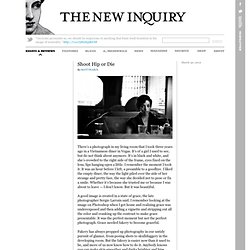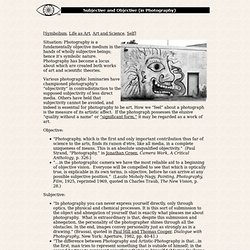

Barthes. Derrida. Ariella Azoulay. Flusser. Geoff Dyer. Lydia Davis. Doing a Photo Critique. Can Photojournalism Survive in the Instagram Era? An Afghan soldier protects his face from a dust storm.Balazs Gardi / Basetrack.org, Creative Commons.

In late May, the Chicago Sun-Times took the unprecedented move of gutting its photography department by laying off 28 full-time employees, including John H. White, a 35-year veteran who had won the paper a Pulitzer. The nation's 8th largest newspaper figured it could cut costs by hiring freelancers and training reporters to shoot iPhone photos, to which Chicago Tribune photographer Alex Garcia responded: "I have never been in a newsroom where you could do someone else's job and also do yours well. Even when I shoot video and stills on an assignment, with the same camera, both tend to suffer. They require different ways of thinking. " Experimenting with iPhone photography is nothing new for journalism outlets. Bending the Frame is a vigorous wake-up call to photojournalists to innovate or die.
The%20new%20interval.
Writing on Photography. The Faux-Vintage Photo: Full Essay (Parts I, II and III) I am working on a dissertation about self-documentation and social media and have decided to take on theorizing the rise of faux-vintage photography (e.g., Hipstamatic, Instagram).

From May 10-12, 2011, I posted a three part essay. This post combines all three together. SUSAN SONTAG: “Looking at War – Photography’s View of Devastation and Death” Tourist Snapshots. John Perivolaris. Shoot Hip or Die. There’s a photograph in my living room that I took three years ago in a Vietnamese diner in Vegas.

It’s of a girl I used to see, but do not think about anymore. It’s in black and white, and she’s crowded to the right side of the frame, eyes fixed on the lens, lips hanging open a little. I remember the moment I took it. It was an hour before I left, a preamble to a goodbye. I liked the empty diner, the way the light piled over the side of her strange and pretty face, the way she decided not to pose or fix a smile.
A good image is created in a state of grace, the late photographer Sergio Larrain said. Fakery has always propped up photography in our untidy pursuit of glamor, from posing shots to skullduggery in the developing room. Actually, it’s a coup; you no longer need high-altitude software like Photoshop like I did, no longer need expensive hardware to crash photography’s beauty party. Writing and photography – is a picture really worth a thousand words? "For photographers, the ideal book of photographs would contain just pictures – no text at all" photographer Robert Adams once wrote.
He went on to admit that he "once worked through more than a hundred drafts of a four-paragraph statement for a catalogue, all to find something that would just keep out of the way of the pictures". Finding words that keep out of the way of the pictures and yet shed light on the nature of photography is nonetheless something that Adams has excelled at, in two books of essays: Why People Photograph (from where that quotation is taken) and Beauty in Photography. Like Stephen Shore, he is a brilliant photographer who also happens to be a gifted and incisive writer. Adams's main subject is the American West, the encroachment of the man-made on the natural.
In his writing, he champions clear and concise language, whether visual or in the written word. Not Ruining the Photo. Recently I spoke at a conference about the American conflict in Vietnam.

This was the first time I had presented a paper at a conference and it was interesting to receive responses after the talk. Some people were really excited by what I had said, some people wanted to argue with me, some people wanted to quiz me, and one guy said this: “Do you think you are kind of ruining the photo by analysing it so much? I mean, these are iconic images, and you’ve got the photographers talking about them, talking about the moment they took them; don’t you think that you’re reading more into it than is really there?” Errol Morris: The Thinking Man's Detective. My favorite private-eye trick is the one I learned about from Errol Morris.

You probably know Morris as an Oscar-winning documentary filmmaker. Roger Ebert called his first film, Gates of Heaven, one of “the ten greatest films ever made.” Essential Readings on Photography. Subjective&Objective. [Symbolism, Life as Art, Art and Science, Self] Situation: Photography is a fundamentally objective medium in the hands of wholly subjective beings; hence it’s symbolic nature.

Photography has become a locus about which are created both works of art and scientific theories. Various photographic luminaries have championed photography’s “objectivity” in contradistinction to the supposed subjectivity of less direct media. Others have held that subjectivity cannot be avoided, and indeed is essential for photography to be art.